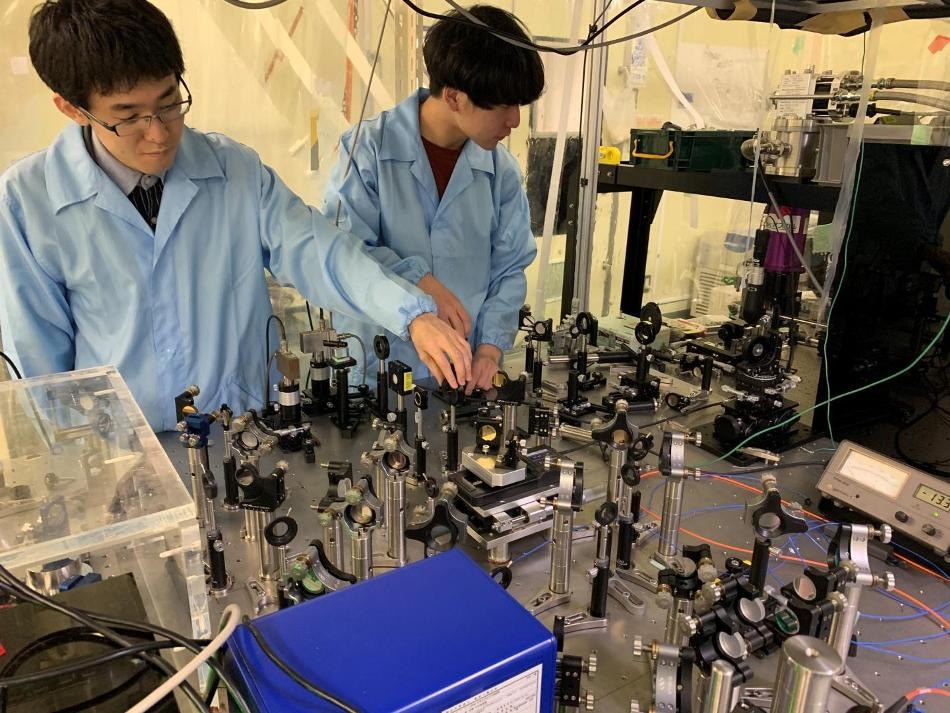May 23 2019
Researchers at Tokyo Institute of Technology and Keio University studied the excitation and detection of photogenerated coherent phonons in polar semiconductor GaAs using an ultrafast dual pump-probe laser for quantum interferometry.
 The research team members of Professor Nakamura Laboratory at Tokyo Tech work with the equipment used for the ultrafast dual pump-probe experiments. (Image credit: Tokyo Institute of Technology)
The research team members of Professor Nakamura Laboratory at Tokyo Tech work with the equipment used for the ultrafast dual pump-probe experiments. (Image credit: Tokyo Institute of Technology)
Assume a world where computers can store, process, and move information at exponential speeds with the help of what is now referred to as waste vibrations, that is, noise and heat. Although this may seem like a scientific-fiction film, with the advent of the nano-age, this will be a reality shortly. At the vanguard of this is research in a branch of the quantum domain: quantum photonics.
Laws of physics help gain insights into the efficient means of nature. However, their application to imperfect lives of humans usually involves the most efficient means of leveraging the laws of physics. Since most of the lives of people are centered on the exchange of information, creating more rapid means of communication has always been the main concern.
Majority of this information is encoded in the vibrations and waves that make use of electromagnetic fields that propagate in space or solids and interact with the particles in solid devices in a random manner, generating wasteful byproducts: noise and heat. This interaction propagates through two channels, absorption of light or scattering by light, both resulting in random excitation of atoms that constitute the solid.
By transforming this random excitation of particles into coherent, well-controlled vibrations of the solid, the conditions can be turned favorable, that is, by using sound (noise!) instead of light to transport information. The energy of this lattice vibration is wrapped up in definite bundles called phonons.
However, the possibility of this depends on the understanding of two basic points—creation of the coherent phonons and its ensuing lifetime for which it retains its “information-transporting ability.” This was the idea behind the question for which the scientists from Nakamura’s laboratory at Tokyo Institute of Technology (Tokyo Tech) are seeking the answer under the partnership of Prof. Shikano, who is working at Quantum Computing Center, Keio University.
Using optical phonons, a particular mode of vibration is described that takes place when the adjacent atoms of the lattice move in the opposite direction.
Because impulsive absorption (IA) and impulsive stimulated Raman scattering (ISRS) cause zapping of such vibrations in the solid lattice leading to phonon creation. Our aim was to shed light on narrowing down this dichotomy.
Nakamura, Tokyo Institute of Technology
The scientists employed dual pump-probe spectroscopy, where an ultrafast laser pulse is split into a more powerful “pump” to excite the GaAs sample and a less powerful “probe” beam shone on the “shaken” sample. The pump pulse is divided into two collinear pulses with a small shift in their wave pattern to generate relative phase-locked pulses. The phonon amplitude is improved or reduced in fringes, based on constructive and destructive interference.
The probe beam interprets the interference fringe pattern by reading off variations in optical properties (reflectivity) of the sample that occur as a result of the fringe pattern-dependent vibrations in the lattice. This technique of reading off the variations in wave pulses to establish the sample characteristics is known as quantum interferometry.
Nakamura and the team state, “Thus, by varying the time delay between the pump pulses in steps shorter than the light cycle and pump-probe pulse, we could detect the interference between electronic states as well as that of optical phonons, which shows temporal characteristics of the generation of coherent phonons via light-electron-phonon interactions during the photo excitation.”
The scientists could filter the information from the quantum mechanical superposition: production of the phonons was principally associated with scattering (ISRS).
Developments in ultrashort optical pulse generation have constantly pushed the ability to probe and control structural composition of materials. Such researches laid the foundations for understanding the vibrations in solids, and thus the next step will involve using them as building blocks for transistors, devices, electronic devices, and perhaps, the future of humans shortly!
The paper has been chosen as Editor’s suggestion of Physical Review B.